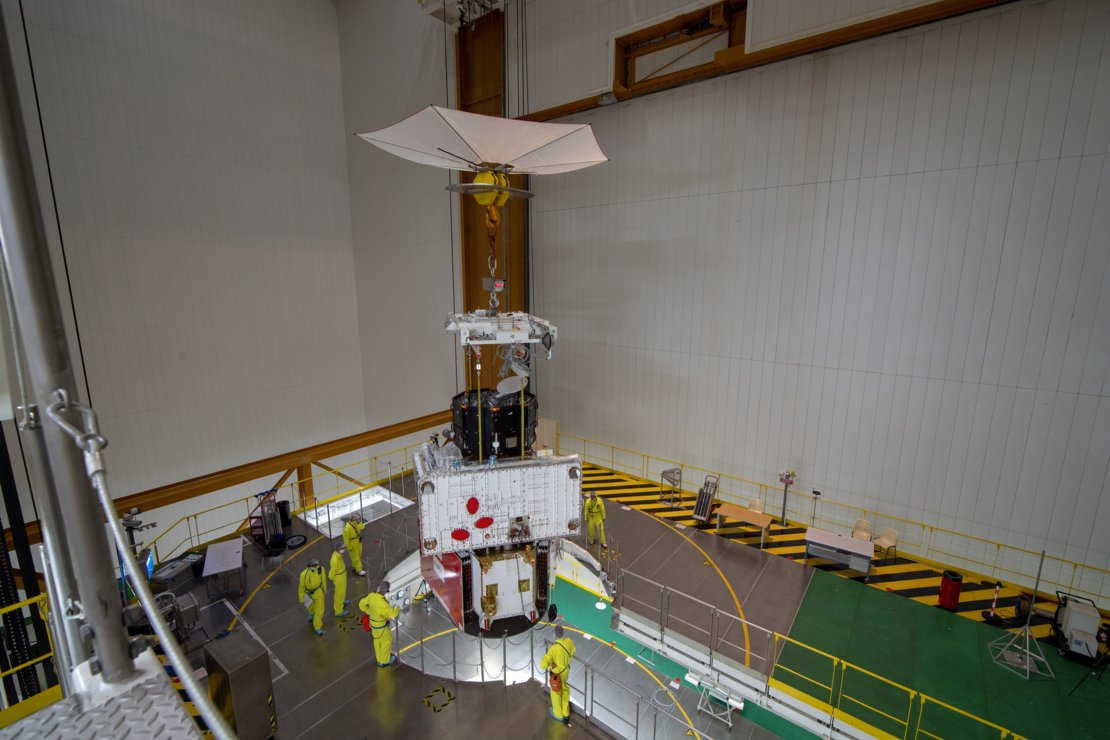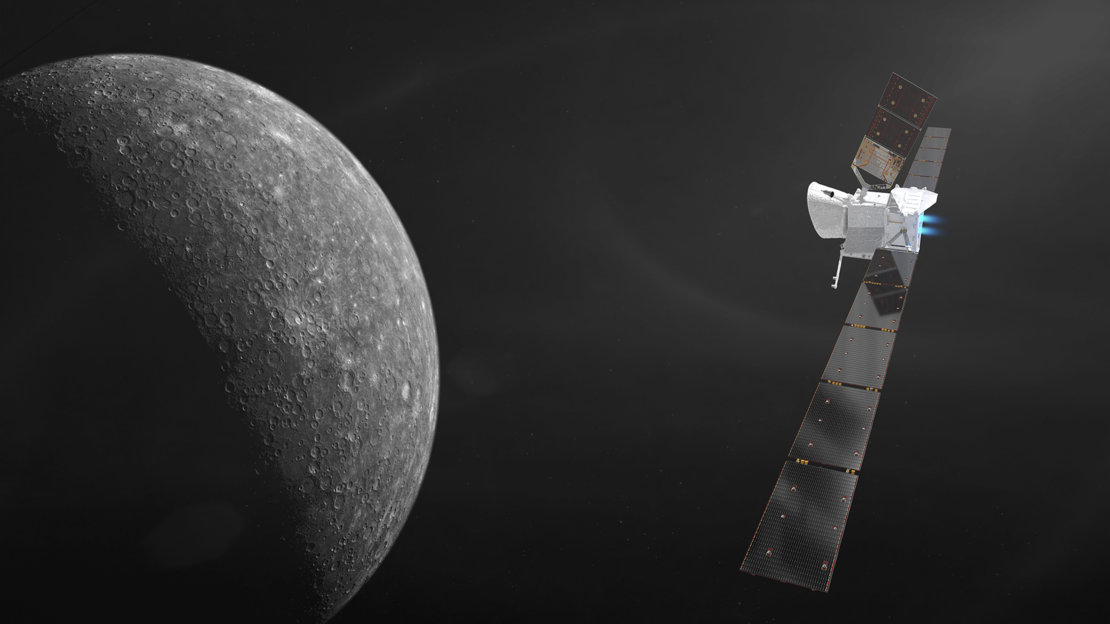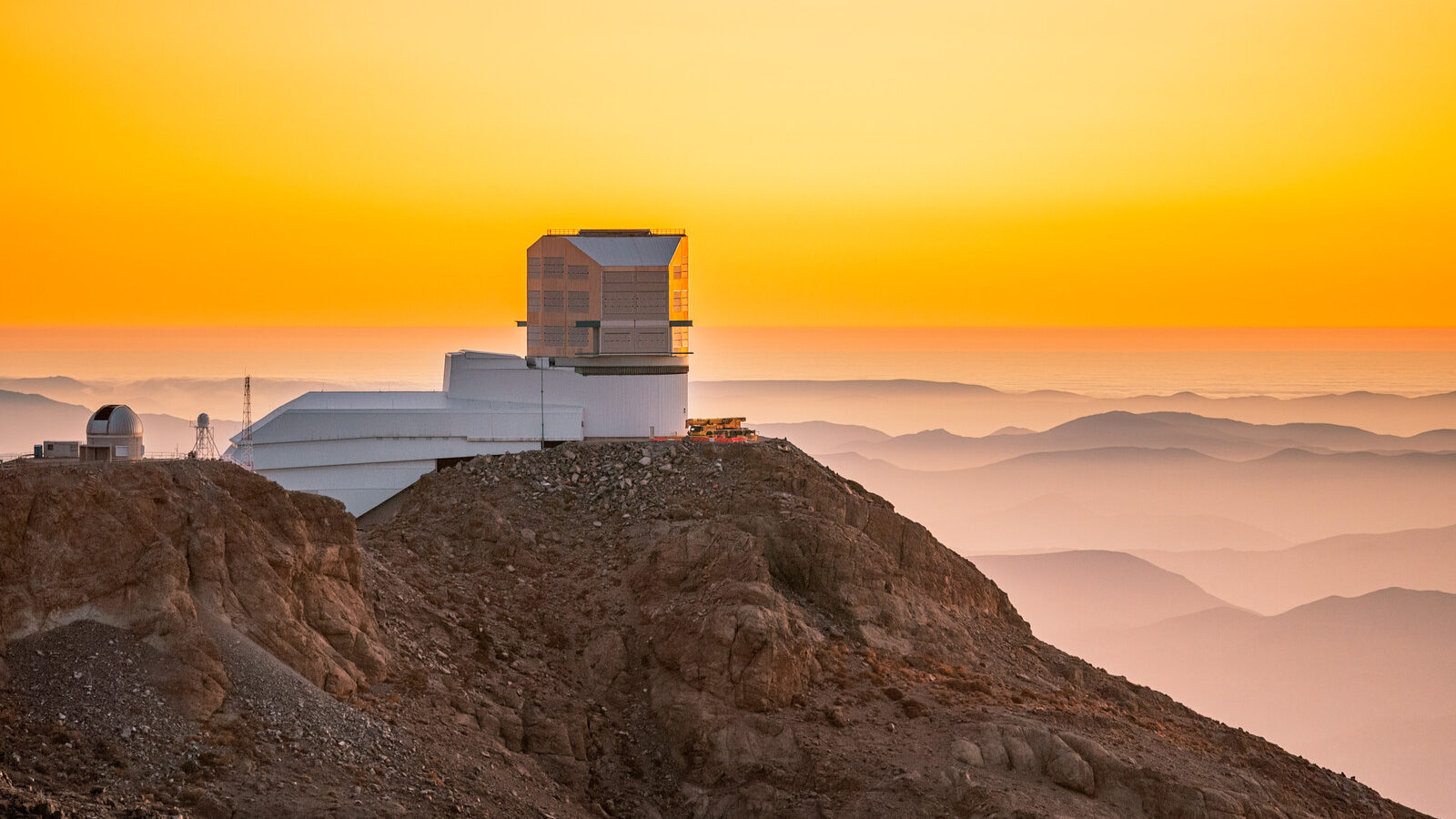BepiColombo Launches This Weekend to Crack Mysteries of Mercury — and Beyond
Mercury is a tiny, shrinking greyish ball of metal, an unassuming neighbor that's easy to overlook — but don't laugh off the possibility that the little world could rewrite our understanding of our own solar system as well as those all around us.
Scientists haven't visited the innermost planet since 2015, but that will change with a mission launching this week: BepiColombo, a joint project between the European Space Agency (ESA) and Japan Aerospace Exploration Agency (JAXA). BepiColombo will launch from Kourou, French Guiana, at 9:45 p.m. EDT Oct. 19 (0145 GMT Oct. 20) on an Ariane 5 rocket; you can watch the launch live at Space.com courtesy of ESA.
The long gap in missions didn't occur because the planet is boring. "Mercury is a challenge in many aspects: to get there, to stay there, and then there are many, many open questions that need to be solved," Joe Zender, deputy project scientist at ESA for the BepiColombo mission, told Space.com. "It's a kind of mystery — maybe one of the last mysteries on the terrestrial planets." [Most Enduring Mysteries of Mercury]
The problem, you see, is that when scientists put together what they know about the whole solar system and build explanations for how it came to be that way, Mercury keeps messing them up. It's the black sheep of the planetary family, with a host of weird characteristics.

Take, for example, how incredibly dense it is, with a massive metallic core surrounded by a thin, rocky shell, like a planetary M&M. Ignore Mercury and the planets line up neatly, from least dense at the center to densest at the edge of the solar system. But that model leaves scientists wondering how a planet so dense could have formed so near the sun. (One idea is that a giant impact stole away most of the lighter material, but that's still just a hypothesis.)
So, scientists want more information about Mercury to feed into their models of how the solar system formed, in hopes of coming up with an explanation that can even account for its strange traits.
But it's not just about our solar system, since our neighborhood is also a stand-in for the hundreds of other planetary systems that scientists have identified over the past couple of decades. Early results suggest those neighborhoods may also often host an unusually dense planet nearest their stars, just like Mercury, making the puzzle still more important to solve.
Breaking space news, the latest updates on rocket launches, skywatching events and more!
"We're discovering more and more solar systems every day," Nancy Chabot, a planetary scientist at the Johns Hopkins University Applied Physics Laboratory who worked on NASA's most recent mission to Mercury, told Space.com. "We're going to first look here, to understand how our own solar system formed, to interpret all of these around us."
BepiColombo to the rescue
Fortunately for stumped scientists, BepiColombo will be uniquely poised to uncover some of Mercury's deepest secrets. "BepiColombo has the instruments to now do intensive investigations of everything from the interior out to the exosphere," James Slavin told Space.com. Slavin, who was referring to the thin layer of gas surrounding the planet like an extremely wimpy atmosphere, studies magnetic fields at the University of Michigan and is co-investigator on one of BepiColombo's instruments."It's just going to be very exciting," Slavin said. "This is the stage of planetary research where we finally get definitive answers to all of the questions we generated on [NASA's] Mariner 10 [mission, which flew by the planet three times in the 1970s] and MESSENGER [(NASA's Mercury Surface, Space Environment, Geochemistry and Ranging mission)]."
BepiColombo, which cost almost $2 billion, according to Spaceflight Now, is made up of two separate spacecraft, the European Mercury Planetary Orbiter and the Japanese Mercury Magnetospheric Orbiter, nicknamed Mio. The two have been joined together in an arrangement that's 20 feet (6 meters) tall for the seven-year-long journey to Mercury; once they arrive, they'll part ways but continue to work in tandem for at least a year. [Photos of Mercury from NASA's Messenger Spacecraft]
Having two spacecraft at the tiny planet will allow scientists to take unprecedented measurements of Mercury's magnetic field by keeping one spacecraft inside that field's bubble and one outside of it. It's unusual enough for such a small planet with a seemingly solid core to have a magnetic field at all, and being so close to the sun means it's constantly bombarded by a heavy stream of charged particles in the solar wind.
Here on Earth, the interaction of solar wind and magnetic field causes space weather, which when particularly strong can cause power outages. But our magnetic field is much stronger, and the solar wind that reaches us is much weaker. "Now we can investigate another different case and an extreme case, with strong solar wind and weak magnetic field, in order to understand how it works," Go Murakami, JAXA's project scientist for BepiColombo, told Space.com.
But that's just one facet of BepiColombo's long to-do list. Other instruments will be studying the planet itself, from its surface to deep down into its core. Geological questions BepiColombo should help scientists tackle include its past volcanic activity and why the already-tiny planet is shrinking. As it carries out its studies, it will be building on MESSENGER's work in the 2010s.
Take, for example, small hollows dotting the planet's surface. "They were one of the examples of why we send spacecraft to places we haven't been before," Chabot said. "They were a totally new landform that was discovered when MESSENGER got into orbit."

The current idea is that the hollows are caused by rock actively sublimating — jumping straight from solid to gas — on the surface, and that the process is still playing out today. "It seems like some sort of volatiles, something that was there and then gets exposed to Mercury's surface, which is hot and close to the sun," Chabot said. "But it's very arm-wavy, because we've only been at this since 2011."
And there's another, more poignant way BepiColombo may follow in MESSENGER's footsteps: by photographing the crater likely about 50 feet (16 meters) across created when the spacecraft, out of fuel 11 years after its launch, slammed into the planet. Now, that abrupt end could be the beginning of new science if scientists can get a good glimpse of the rubble that the impact carried to the surface. "We know exactly when it happened," Chabot said, which means they can study how that rock weathered.
There's just one catch for BepiColombo: It will take the spacecraft seven years to fall into orbit around Mercury. Along the way, the spacecraft will fly past Earth once, Venus twice and Mercury itself six times, in a complicated dance designed to avoid the massive pull of the sun.
"We still have a very long way in front of us," Zender said, "but we are all very excited that we start the long journey now."
Email Meghan Bartels at mbartels@space.com or follow her @meghanbartels. Follow us @Spacedotcom and Facebook. Original article on Space.com.
Join our Space Forums to keep talking space on the latest missions, night sky and more! And if you have a news tip, correction or comment, let us know at: community@space.com.

Meghan is a senior writer at Space.com and has more than five years' experience as a science journalist based in New York City. She joined Space.com in July 2018, with previous writing published in outlets including Newsweek and Audubon. Meghan earned an MA in science journalism from New York University and a BA in classics from Georgetown University, and in her free time she enjoys reading and visiting museums. Follow her on Twitter at @meghanbartels.
